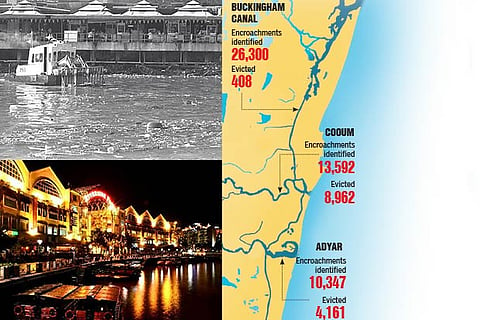

Chennai
It took only about a decade for Singapore to clean up its river, which included unlocking the potential contained in the areas surrounding it. In Chennai, there have been loud talks for the past few decades of undoing the gross damage caused to the Buckingham canal, and the Cooum and Adyar rivers. But nothing concrete has transpired, and these waterways continue to remain channels carrying muck and sewage.
Unlike Singapore, which was handed over a dirty river to clean at the time of its independence in 1965, the Buckingham canal was an active waterway until 1961, connecting important trade centres like Kakinada, Rajahmundry and Vijayawada. It was turned into a sewer primarily due to government apathy and lack of political will to safeguard it. The fate of Cooum and Adyar rivers is the same, which are used to drain the city sewage while their banks turned into home for squatters.
Though there have been no dearth of schemes and missions to clean them up, nothing has changed on the ground. There is a lack of political will and a laggard bureaucracy, coupled with public apathy on the need for a clean environment.
Hearing a batch of petitions seeking to clean up Chennai’s waterways and restore them to their pristine glory, the National Green Tribunal (NGT), South Zone, had imposed a fine of Rs 100 crore on the State government for continuing to keep them as sewage carriers despite several directions it had given.
Observing that Adyar and Cooum were two of the most polluted rivers to flow through any major urban agglomeration anywhere in the world, the NGT held the government accountable for it. The tribunal even accused the authorities of colluding with the polluters and violators.
“The magnitude of the damage to the environment is huge and there has been a long history of consistent failures of the State of Tamil Nadu and its authorities,” the NGT principal bench comprising Chairperson Justice AK Goel, Justice K Ramakrishnan and expert member Nagin Nanda said in the order.
However, there has not been any improvement. Instead, the government is busy fighting the fine imposed by the NGT, initially moving the High Court and now the Supreme Court.
Activist Jawaharlal Shanmugam, on whose plea to clean up the Buckingham canal that NGT had imposed the fine, said, “The Singapore model is a classic example of how we can undo the damage caused to the waterways and the rivers, and above all safeguard them. There are many such examples in countries like Germany and Korea where the vision and mission for a sustainable development have worked. But unfortunately, the lack of a holistic approach and vote bank politics that allows encroachments have been the bane for our precious waterways and rivers.”
Nearly four decades ago, the Singapore river banks were filled with squatters, hawkers and industries, leaving it severely polluted. Calling for a large-scale clean-up of the rivers, the visionary leader of the tiny city-state, the then prime minister Lee Kuan Yew said in 1977: “It should be a way of life to keep the water clean. To keep every stream, culvert and rivulet, free from pollution. The Ministry of Environment should make it a target: in 10 years, let us have fishing in the Singapore and Kallang rivers. It can be done.”
The clean-up involved a massive relocation of about 4,000 squatters, along with hawkers and vegetable sellers. Squatters were provided public housing, while street hawkers were moved to hawker centres. Hundreds of bumboats ferrying goods from warehouses along the river to cargo ships out at sea were moved to a new lighter anchorage at Pasir Panjang by the Port of Singapore Authority.
Foul-smelling mud was dredged and removed from the river bed and banks, and debris and other rubbish were cleared. It was spearheaded by Lee Ek Tieng, an 81-year-old civil engineer, the then Environment Ministry Permanent Secretary. The completion of the project within the deadline earned him a gold medal in 1987, and an acknowledgement from Lee Kuan Yew himself in his memoir.
Buckingham Canal
Departments involved in restoration work
Chennai Rivers Restoration Trust to coordinate & monitor the projects | Chennai Metropolitan Water Supply and Sewerage Board | Greater Chennai Corporation | Public Works Department | Commissionerate of Municipal Administration | Directorate of Town Panchayats | Tamil Nadu Slum Clearance Board | Department of Rural Development
Failed Schemes and Sanctions
Govt lethargy
Latest plan To restore waterways
Latest Plan Envisaged
Back home in Chennai, the latest effort was in July when the Chief Minister Edappadi K Palaniswami announced a Rs 2,371 crore project to mitigate and plug sewage flow into the Cooum and Adyar rivers, and Buckingham canal. In August, Municipal Administration department accorded an administrative sanction of Rs 1,001 crore for the first phase of the project, adding that an eco-restoration plan for Cooum and Adyar rivers has been prepared to rejuvenate their ecosystem.
The success story of Singapore offers fond hope that if there is a strong political will, the city waterways could also be transformed within a time frame. While the government ought to take a cue from it, it is equally important that the people and corporates throw in their lot in making the task of turning the city truly the ‘Singara Chennai’ everyone longs for.
(The writer was in Singapore on the invitation of Singapore International Foundation.)
Visit news.dtnext.in to explore our interactive epaper!
Download the DT Next app for more exciting features!
Click here for iOS
Click here for Android